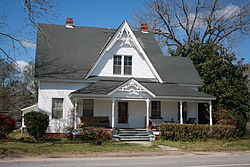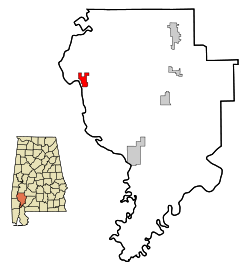Coffeeville, Alabama
| Coffeeville, Alabama | |
|---|---|
| Town | |

Victorian house on Alabama State Route 69 in Coffeeville
|
|
 Location in Clarke County and the state of Alabama |
|
| Coordinates: 31°45′40″N 88°5′20″W / 31.76111°N 88.08889°W | |
| Country | United States |
| State | Alabama |
| County | Clarke |
| Area | |
| • Total | 4.5 sq mi (11.7 km2) |
| • Land | 4.5 sq mi (11.7 km2) |
| • Water | 0 sq mi (0 km2) |
| Elevation | 174 ft (53 m) |
| Population (2010) | |
| • Total | 352 |
| • Density | 78/sq mi (30.1/km2) |
| Time zone | Central (CST) (UTC-6) |
| • Summer (DST) | CDT (UTC-5) |
| ZIP code | 36524 |
| Area code(s) | 251 |
| FIPS code | 01-16264 |
| GNIS feature ID | 0116356 |
Coffeeville is a town in Clarke County, Alabama, United States. At the 2010 census the population was 352.
The town of Coffeeville was incorporated in 1817.
In 1892, Coffeeville was the site for a violent confrontation around economic and racial divides that later became known as the Mitcham War.
In 1939, racial violence in Coffeeville was brought to the attention of President Franklin D. Roosevelt after a near-lynching in which the mayor of Coffeeville was complicit.
Coffeeville is located in northwestern Clarke County at 31°45'40.543" North, 88°5'20.940" West (31.761262, -88.089150), on high ground on the east side of the Tombigbee River.
According to the U.S. Census Bureau, the town has a total area of 4.5 square miles (11.7 km2), all land.
As of the census of 2000, there were 360 people, 165 households, and 97 families residing in the town. The population density was 79.7 people per square mile (30.8/km2). There were 209 housing units at an average density of 46.3 per square mile (17.9/km2). The racial makeup of the town was 61.11% White and 38.89% Black or African American.
There were 165 households out of which 22.4% had children under the age of 18 living with them, 40.6% were married couples living together, 13.9% had a female householder with no husband present, and 41.2% were non-families. 40.6% of all households were made up of individuals and 21.2% had someone living alone who was 65 years of age or older. The average household size was 2.18 and the average family size was 2.95.
In the town, the population was spread out with 23.9% under the age of 18, 6.9% from 18 to 24, 23.1% from 25 to 44, 25.3% from 45 to 64, and 20.8% who were 65 years of age or older. The median age was 42 years. For every 100 females there were 80.9 males. For every 100 females age 18 and over, there were 80.3 males.
...
Wikipedia
